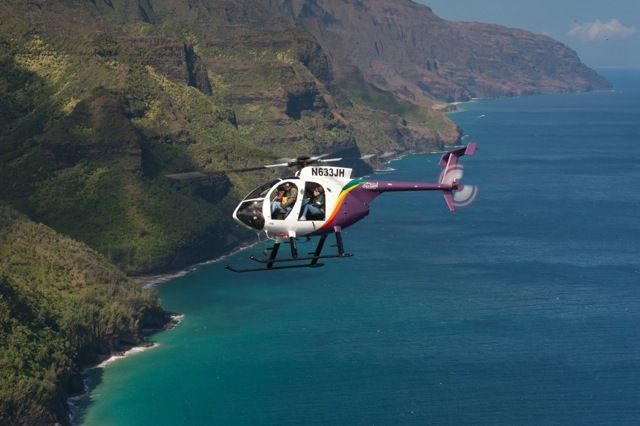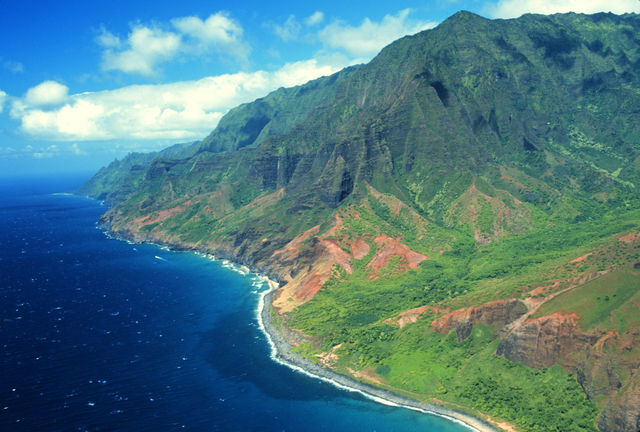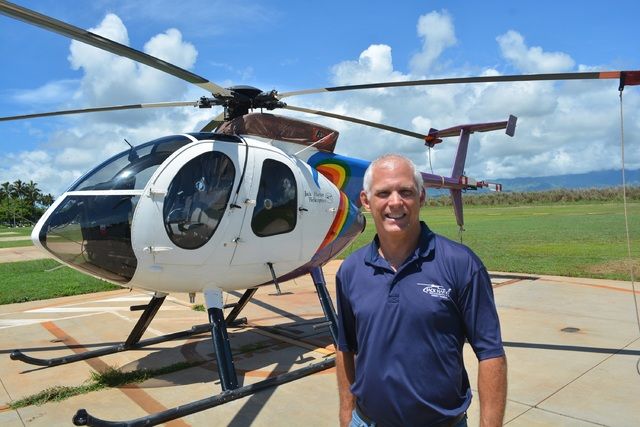Talk Story: Casey Riemer
LIHUE — When Jack Harter first visited Kauai, he realized that the island’s topography makes it a very special place, but that much of its beauty can only be seen from the air. And when he brought his Bell 47G to Kauai in 1962 so he could give air tours, he launched a new island industry.
Back in those days, there weren’t many regulations and Harter used to be able to land most anywhere, so he’d pick people up from the beach and take them to see the Na Pali Coast, even landing at the Honopu Arch. One time in the early 60s, he took a man and woman out there to get married, but when the excited bride jumped out of the helicopter too early, her veil got sucked up into the spinning rotors. A few years ago, Jack Harter Helicopters took that same woman out there again so she could spread her husband’s ashes over the area where they got married decades before.
Although still involved with the company, Harter has largely turned control over to his general manager Casey Riemer, who now oversees operations. Riemer sat down with The Garden Island to talk story about what it is like to run a helicopter tour business on Kauai.
Has the bad weather we’ve been having recently affected your business?
The hurricane season we’re having right now has had some effect on us, although one of the best times to fly is right after a big rain event comes through. All the waterfalls are just filled in every nook and cranny and valley around the island, and then you get an idea of how the island was shaped by all the erosional and weathering forces that Mother Nature brings along.
When do you cancel tours?
When we decide to not fly, it’s because of two things: first it’s got to be safe, second it has to be worth the customer’s time and money. We want to be able to take them to Na Pali, we want to be able to take them to Waimea Canyon, show them the North Shore. And if the clouds are too low or there is too much rain or the winds are too high and turbulence is too bad, then we’ll cancel the flight. But our customers tend to watch the weather themselves and they don’t even make reservations on times when it’s going to be bad to fly.
You were up in the air shortly after Hurricane Iniki hit. What was that like?
After Hurricane Iniki, the level of devastation was just amazing. It was like someone just went over the island with a steamroller.
That was an interesting time for Jack Harter Helicopters. Jack was hired to be on standby and do a lot of work for construction companies, cell phone companies, utility companies. We were able to do a lot of recovery work, take people out into remote areas to survey damage. And then there were a few flights where people just wanted to go see what happened to the island.
But there wasn’t a lot of tourism business at that time.
It took a long time, it was five or six years until the effects of Hurricane Iniki were gone. After the hurricane, you’d see a lot of tarps on roofs, and a sign of recovery is fewer tarps on the roofs as you are flying around.
We just started building the business back up, as tourism started coming back.
How long had you been with the company at that point?
I started working for the company in 1988 (after he moved to Kauai from Alaska). I started helping with things around the office, started helping with some maintenance, then in ’94, I started working full time in the office, then shortly thereafter I moved into the position as general manager.
What kind of aircraft do you fly?
We have one Airbus A-star helicopter. It seats six people plus the pilot. It’s an air-conditioned aircraft with floor to ceiling windows. And we’ve moved the pilot’s seat from its traditional spot on the right-hand side to the left-hand side, because we generally fly clockwise around the island.
Moving the pilot’s seat (was a custom change that) cost about $100,000, but it provides a tour in an aircraft that is really well-suited for flying around Kauai. And the other thing we like about having the pilot located on the left-hand side of the helicopter is it keeps the pilot controls well away from the customer (laughs).
We also have several Hughes 500s, which we got because we wanted to be able to fly the tours with the doors removed. Many people like the feeling of adventure of flying with the doors removed. We don’t fly the aircraft any different on a flight than we do the other aircraft with the doors on (but) it feels very adventurous. The people who go up with the doors off come back with huge grins on their faces, after doing something they never thought they would do.
There are many people who should never go up without the doors — they just cannot do it!
We are the only company that has two very distinct types of aircraft we fly. We want to make sure our customers make a good decision, but it’s their decision on which aircraft to fly in — either with the doors on or the doors off.
How much do those costs?
A brand new A-star will cost you $2.2 million – actually it’s probably more like $2.4 million completed the way we do it. The Hughes 500 (actually an MD 500E – Hughes is the old name) is $1.8 million.
How long do the helicopters last?
A helicopter will last as long as you take care of it. There are many old airplanes and old helicopters flying around. It gets more expensive to maintain them as they get older, but we have a maintenance cycle with our aircraft.
They go through a series of inspections – we do 100 hour, 150, 300, 600, and 1200 hour inspections. Some of the aircraft have to go through an annual inspection that is done every calendar year. And the procedures that we go through are all dictated in the maintenance manuals for each aircraft type.
A complete overhaul will cost $300,000 to $600,000.
So this is why helicopter tours are one of the more expensive activities to do on Kauai.
Helicopters are not inexpensive to operate. Every hour we fly the aircraft, we have components including the engine and rotor blades and many other moving parts, that we need to put money away in a maintenance reserve account, to cover our expenses when they come due either for retirement or overhaul.
Have you ever had an accident?
In the existence of Jack Harter Helicopters, we’ve had one accident. It was in 2003, it was a tragic accident and we’re still not sure exactly what happened, but it was a very experienced pilot, and four people up in a Bell Jet Ranger, over Mt. Wailaleale, and unfortunately nobody survived the accident.
Every company on this island has had an accident, some of them have been fatal, some of them haven’t. There is nobody with a perfect safety record.
Because of what we do, we understand the risks and we do everything possible to mitigate the risks. Our first priority is safety.
Explain why people have to step on a scale when they check-in.
We have a weight limit — we have to follow the aircraft manufacturer’s flight manual that deals with the weight and balance of the aircraft.
So we take people’s weights when we make a reservation, and then we verify it when they come to the office.
How many people take helicopter tours?
My understanding is at least 10 percent of the visitors that come to Kauai each year, go on a helicopter tour. Kauai is one of the best places if not the best place in the world to take a helicopter tour.
In an hour, you can see things that first off you can’t access in any other way than being in the air over them, and because of the very steep valleys, and the topography on the island and the coastal areas, a helicopter can get in you in to see things that there is just no other way to see.
What will people see on one of your tours?
We offer a 60-minute tour and a 90-minute tour. When we take off from the Lihue Airport, we generally go clockwise. We’ll fly over the Nawiliwili Harbor, the Menehune Fish Pond and see Kip Kai in the distance as we head to the west toward Mt. Kahili. The first valley we go into is the Hanapepe Valley, where Manawaiopuna Falls (Jurassic Park Falls) is located.
Me, I think it is a beautiful waterfall, but right above that waterfall here are five other waterfalls, the Kahili Falls, that I think are even more beautiful. From there we will go across the Robinson Land to Olokele Canyon and Waimea Canyon. Some of the tours will go into Olokele Canyon — especially the 90-minute tour. All the tours will go into Waimea Canyon, and if the conditions are right we’ll go into all of the major ventricles in the canyon.
From there, we will go around the Kokee State Park area, to Na Pali. Along Na Pali we’ll get panoramic views from both ends of the coastline, a little bit off shore. We’ll generally go into the Awaawapuhi Valley, Nualolo Valley, then we’ll go along the coast to Kalalau. And then we go along toward Kee Beach, and you’ll see Hanakoa Falls and Hanakapiai Falls along the way.
From Kee Beach we’ll go along the North Shore and you’ll see the mountains and Tunnels reef. We’ll be up a little higher in that area because it is a very noise-sensitive area, and the views from up high are really beautiful. Then we’ll turn inland and view the waterfalls, and then we’ll take the Hanalei valley into the center of the island, and then we’ll go into the area that has been dubbed the crater of Kauai. And we’ll fly into that and take you into a place that you never even imagined existed.
How high to you fly when you are in the crater?
We’ll be at least 500 feet above the ground when we are in that area — it is one of the areas on our tours that we are allowed to go down to 500 feet by the FAA rules. So we’ll be in a valley that has 3000 foot walls and we’ll be basically a sixth of the way up the wall. There are many times when the clouds are higher, it makes sense to be higher. There are times when the top of the island is clear — not often but it happens. And we can fly over the top of the island, and you’ll see the Alakai swamp, and you’ll see the rain gauge at Mt. Waialeale, and you’ll see the highest peak.
I notice there isn’t a display on the scale.
The verification is done in a very discrete way. The scale has a remote display, so our staff checking the person in knows how much the customer weighs, but no one else sees it. Many customers don’t want their significant other to know how much they weigh (laughs).
Weight and the need to balance the aircraft determines where people sit. We take customer requests, but they are only requests because we have to make sure we balance things out for safety.
Do you ever land up there?
We can land but we need state permission, because it is state land. If we have a customer that wants to go up there like USGS to check the rain gauge or a biologist, we go up there.
How much does a tour cost?
The 60 to 65 minute tour is $289, all inclusive. For the A-star, we offer an Internet and kamaaina discount of $30 off.
Why should someone who lives here take a tour?
Many of the people who fly with us are older folks, many of them who have never seen Na Pali.
A helicopter tour is a great way to see all these areas that are hard or impossible to get to.
One of my pilots had a neighbor – 74 years old — who had lived all but four years of her life here when she went to college to become a teacher, and she came back from the flight and was super appreciative of what she’d done and seen, but she was also in awe of the island and couldn’t believe it’d taken her so long to see the island she’d lived on all these years.
How many flights does Jack Harter Helicopters fly per day?
We only fly 6 hours per day per pilot. So on a busy day we’ll fly 24 flights, between our four aircraft.
How big of an operation is it? How is business going?
We have 26 people on staff total — six pilots, six mechanics, and the rest of the crew is office and administrative.
In 2012, we decided that we needed to make an investment in the company to better maintain our aircraft, and to have better aircraft availability. We’d been working with a contractor for many years, but it limited our aircraft availability, so we secured a spot at the airport and erected a very nice maintenance facility that lets us do our maintenance at night, so that the aircraft are available to fly during the day. It’s very rare that we need to do maintenance during the day.
The year 2015 is going to go down as a very good year for Jack Harter Helicopters.
You also do some work that is not tourism related.
We have the ability with the Hughes 500 to do external load work. One of the things that we get asked to do occasionally when there is a large brush fire is to have one of our helicopters with the fire bucket to go out and help the county of Kauai put the fire out.
We’re in the process now of equipping our larger aircraft with an external load hook, that we will then be able to carry an even bigger water bucket, and do even heavier load work.
Recently we did some work at the Kukui Grove shopping center moving air conditioners for a couple of tenants up there. We moved four air conditioners in about 10 mintues. It’s a precision type of work, but we have pilots that can do that.
One thing some residents complain about with your industry is sound.
One of the things the long-term operators of helicopters have recognized is that Kauai is a very special place, it’s a very small island, and our helicopters make noise. To be able to co-exist with the people that live here on the island, we formed a group of operators that has a fly-neighborly program. That gives us general areas where we fly and the altitudes we fly. There are certain areas of the island we try to avoid, there are areas we fly higher, and there are remote areas where nobody is out there where we fly lower.
We can go 200 feet over a razorback ridge, because there are many places where if you want to stay 500 feet above the ground it would be like a rollercoaster ride to follow the terrain, and the FAA recognizes that there is no additional danger to go over a ridge at 200 feet.
Many times sound issues occurs when the environmental conditions don’t mask our noise. When the surf is up and the wind is blowing, and the helicopters are flying over Lumahai Beach, it’s very hard to hear our helicopters at 1,500 feet and a half mile off shore. When the wind dies and there is no surf, you’ll hear every helicopter and airplane that flies over.
Jack Harter Helicopters has had a long history on this island. Tell me something that many people do not know.
Something many people remember is back in the earlier days of Jack’s companies, he used to be able to land along the Na Pali, and specifically he used to land at the Honopu Arch, and he did that until the mid-80s.
In the mid-80s, he was approached by the state Department of Natural Resources, and he was told that the permit he had wasn’t exclusionary for all the other helicopter companies, but he had a choice — he got to decide if every helicopter got to land along Na Pali, or nobody got to land along Napali.
And he decided to give up the ability to land out there on his tour flights. It was a very significant loss, but the island has been preserved in a way that many people don’t recognize.




